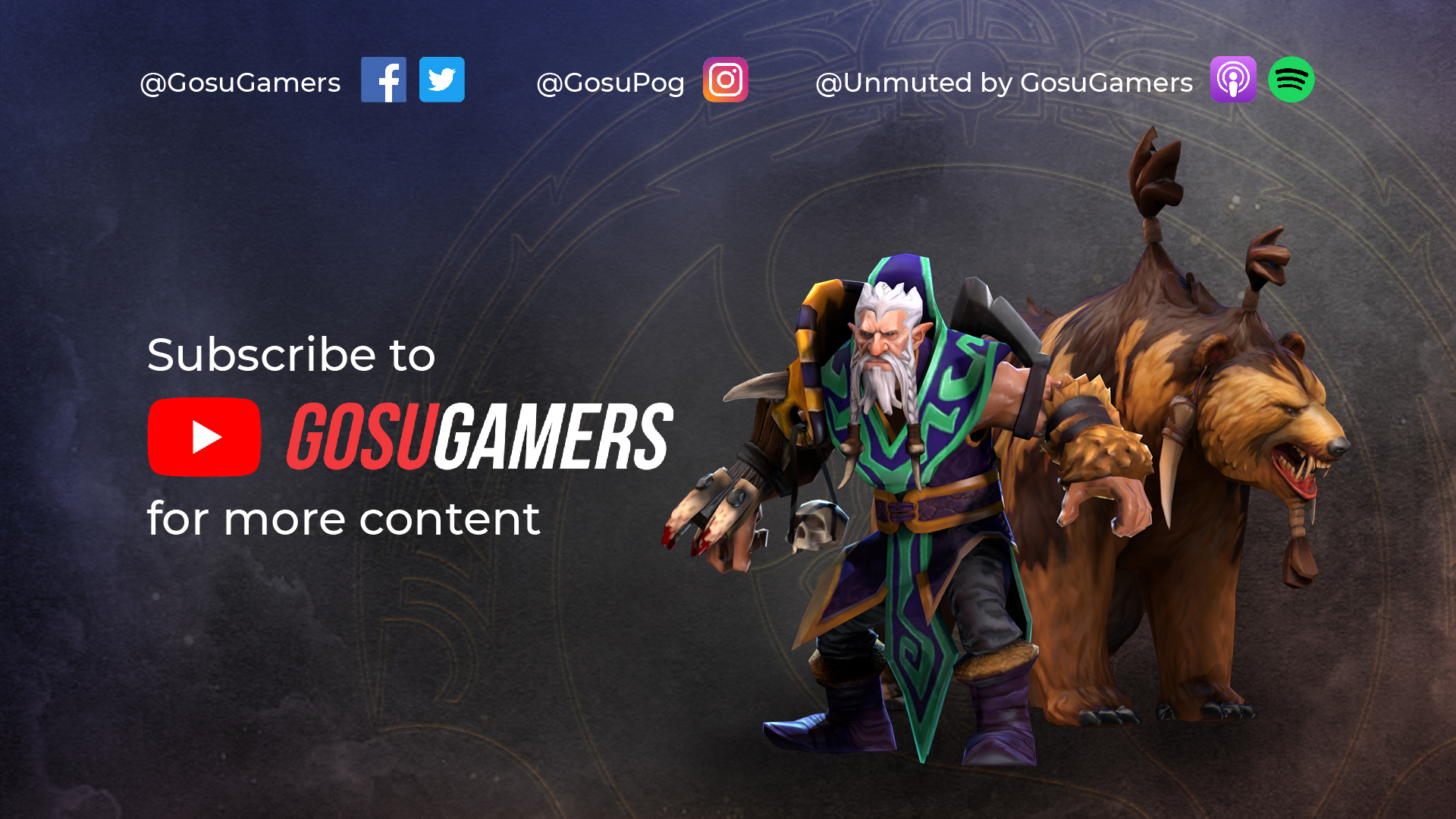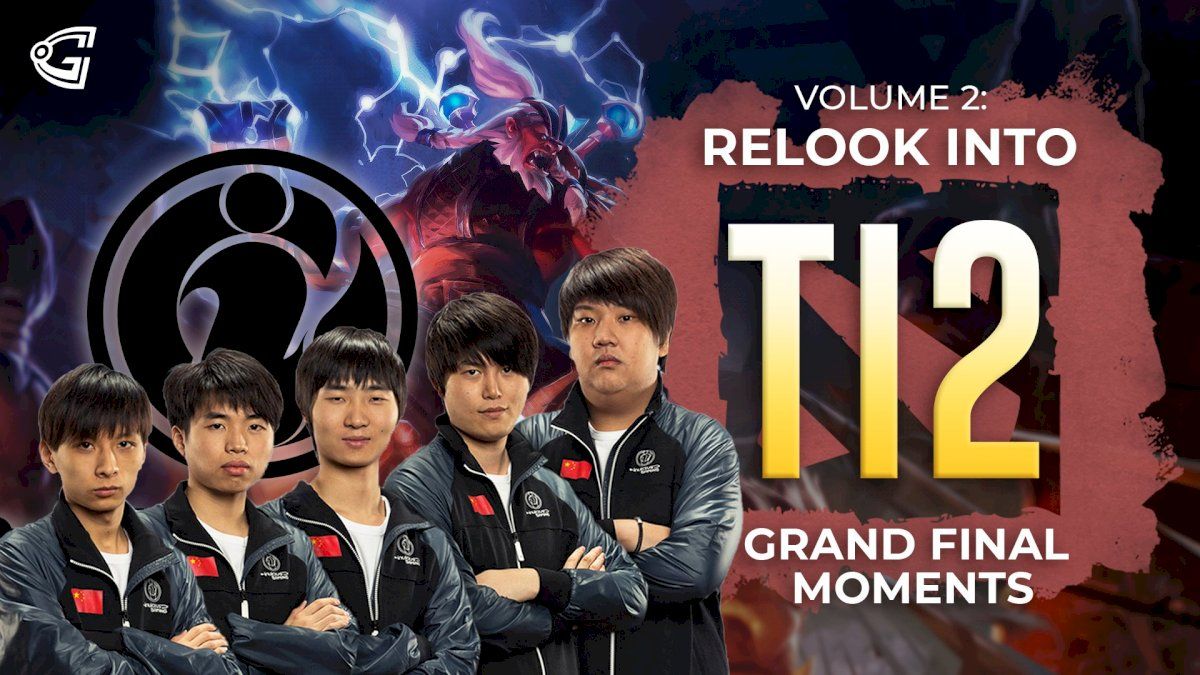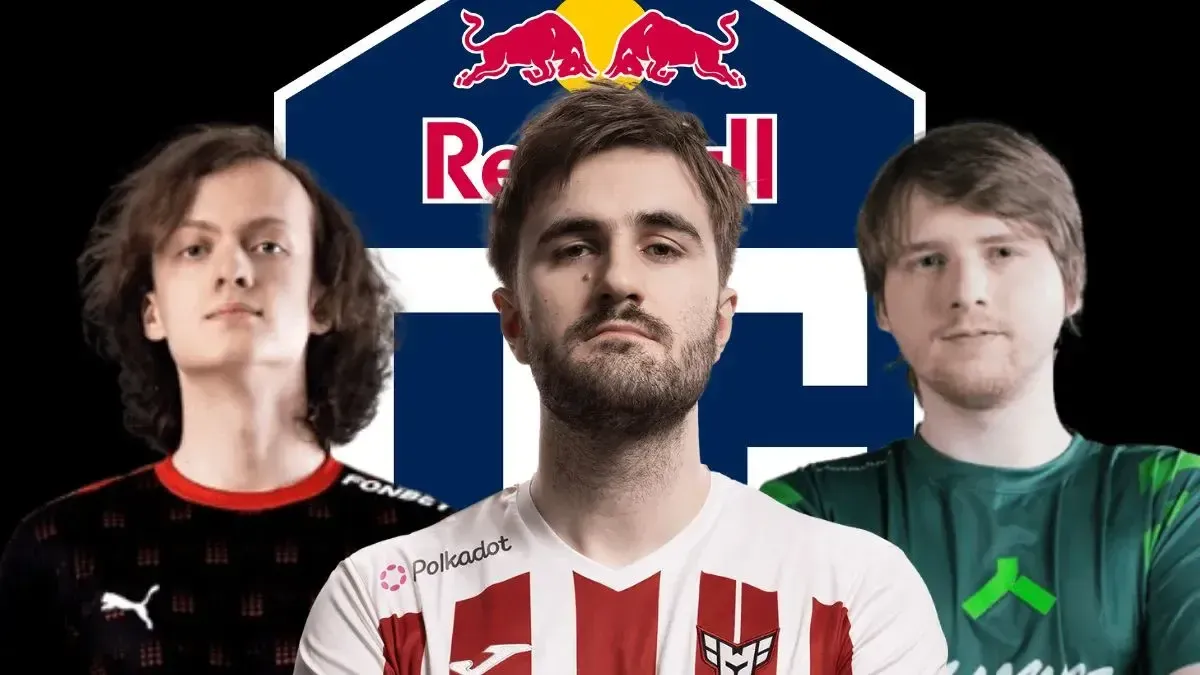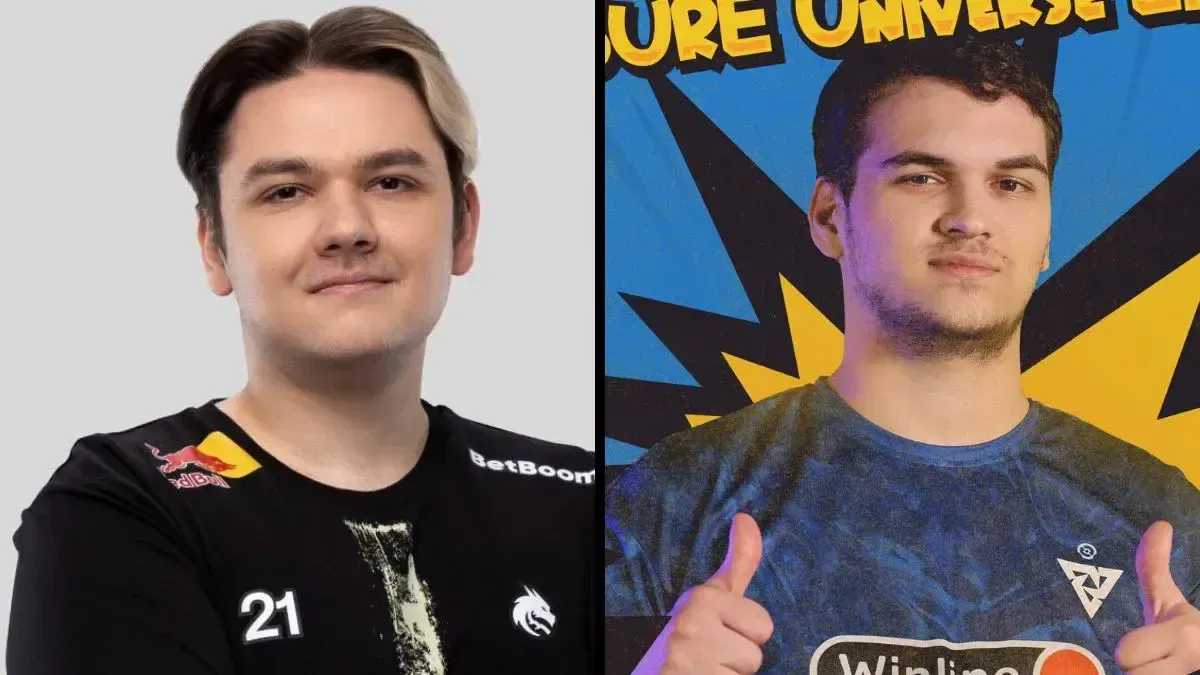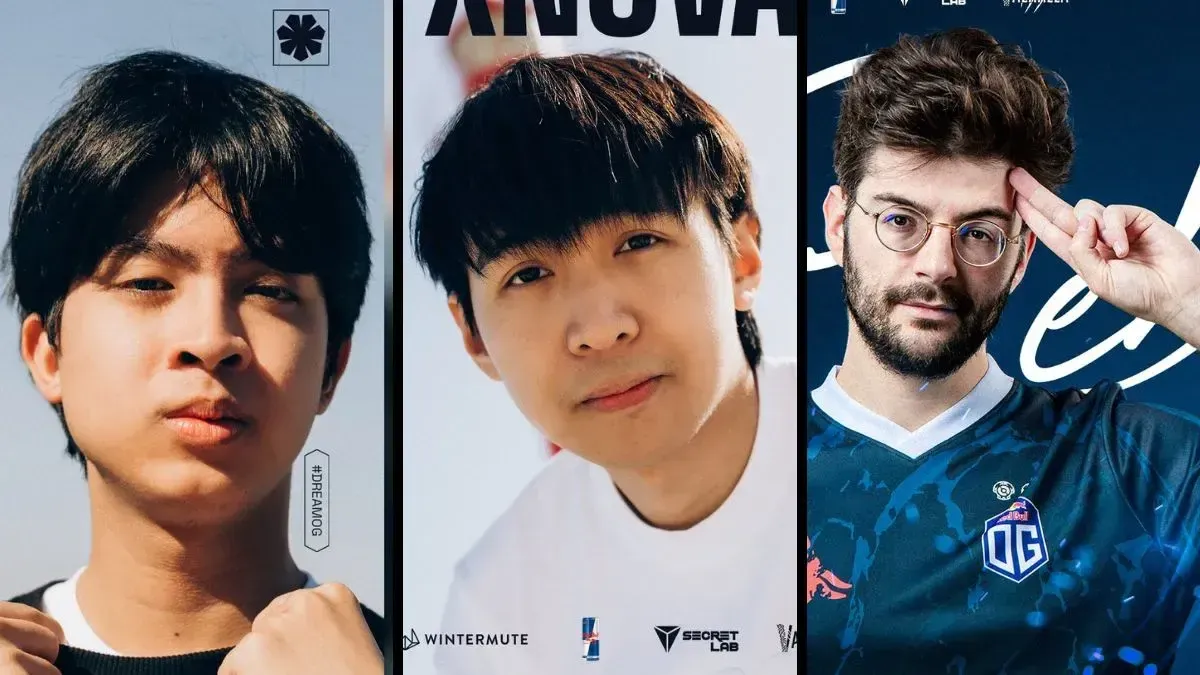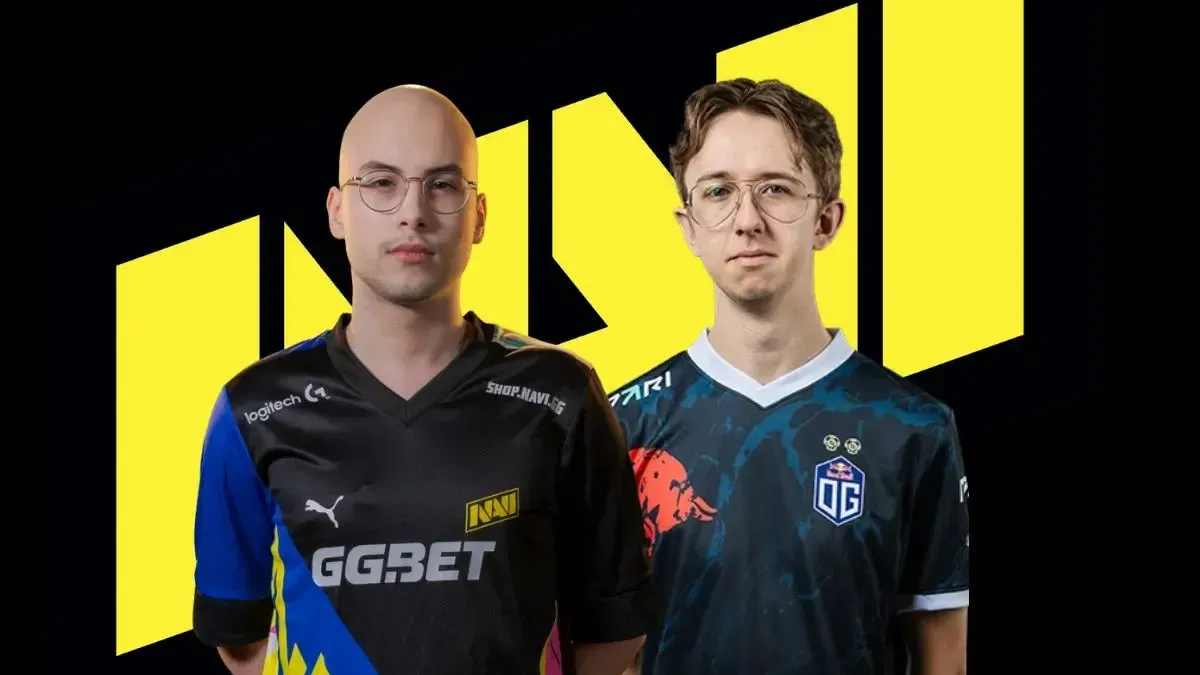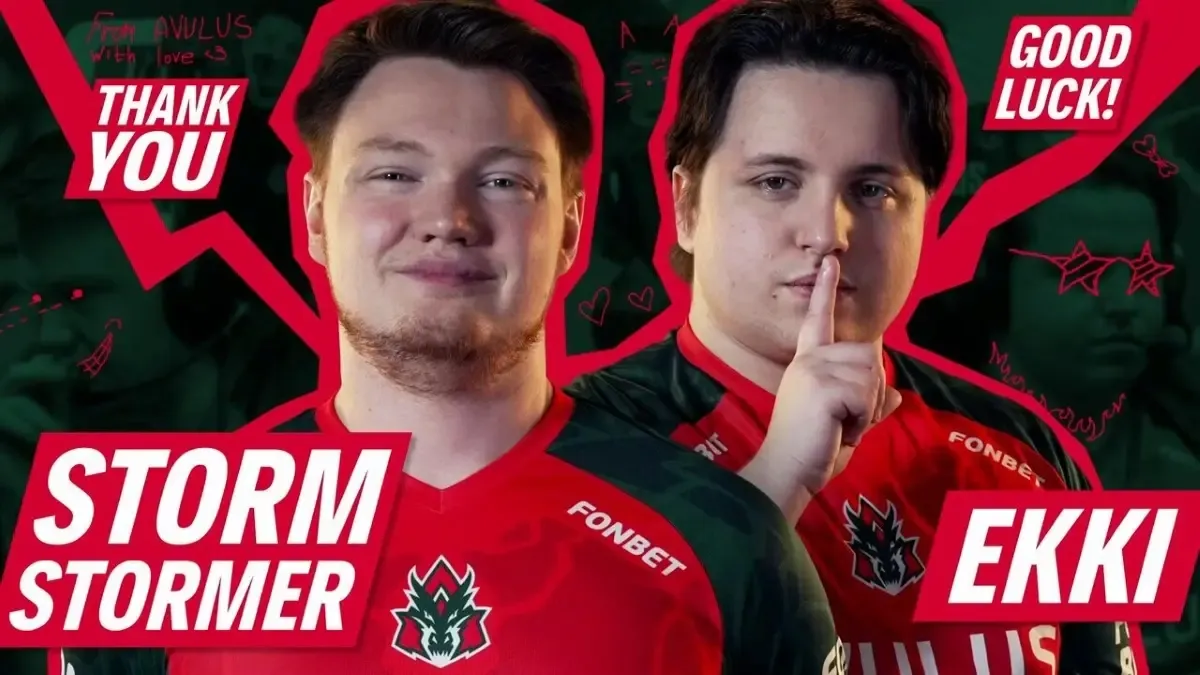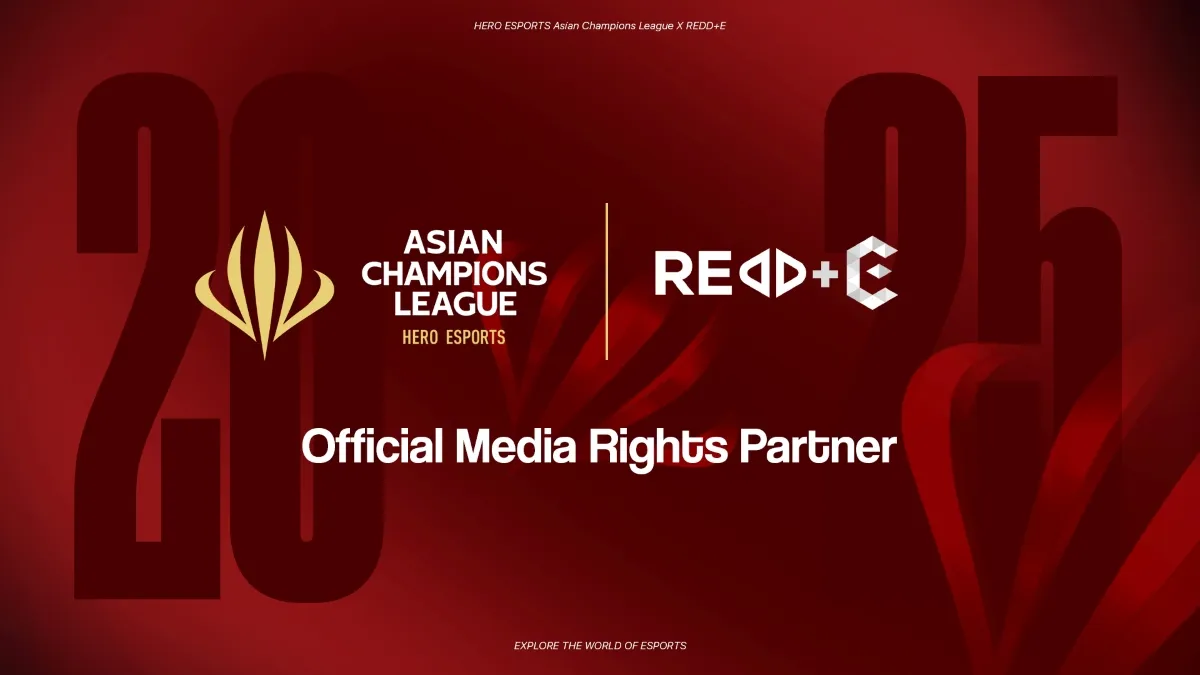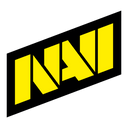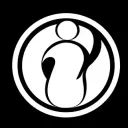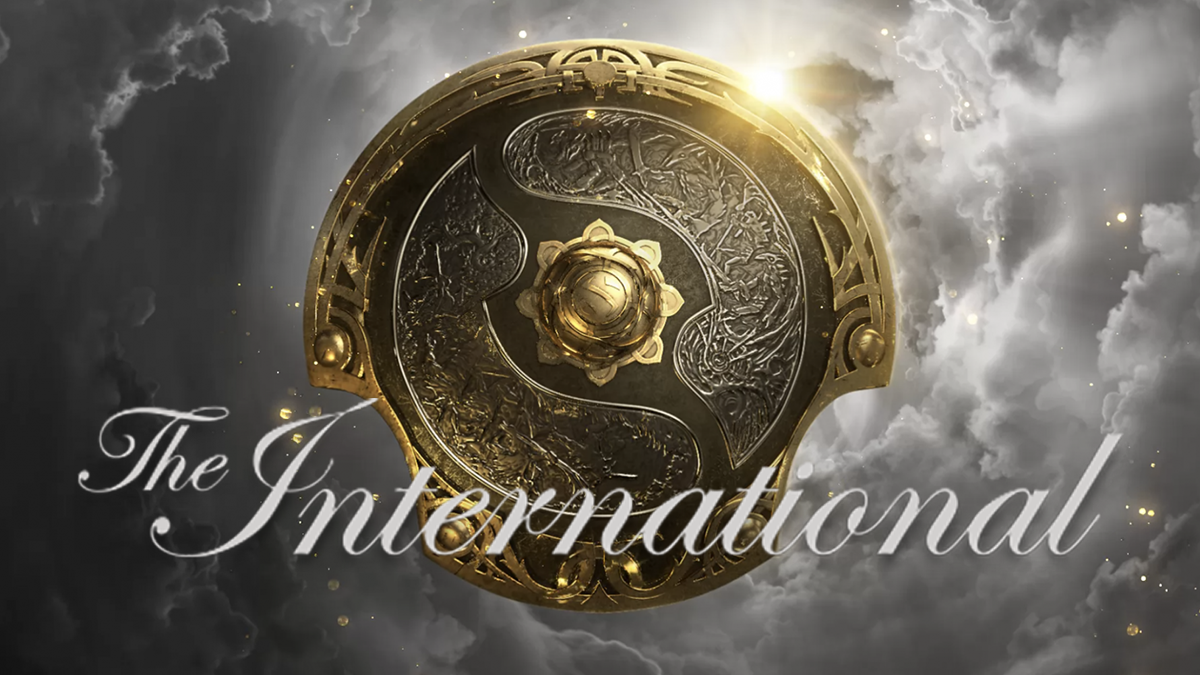During the next 9 weeks GosuGamers will be taking a closer look back at the meta for each of The Internationals through the years. This week is TI2.
The International 2011, or TI1, took everyone by storm with its insanely high prize pool. But after its success, it set a path for not just Dota 2, but other games to show the world where esports can go. Na’Vi won the first iteration of the tournament and started to accumulate a cult following for their heroics. As the competition travelled from Cologne to Seattle for The International 2012 (or TI2) after a year, there were a lot of differences inside and outside the game. But one thing that was constant was Na’Vi being dominant.
TI2 had the same prize pool as TI1, which was $1.6 million, with the winner taking home a million dollars. The brilliant concept of Compendium or Battle Pass was not yet introduced to the game so for TI2 again, it was all done with Valve putting in the reward money.
Format
The format for The International 2 was a bit different than TI1. There were 16 teams, out of which 13 were invited, two made it through the qualifiers (West qualifiers and East qualifiers) and one team making it through the wildcard slot (Kuro “Kuroky” Salehi Takhasomi only made it to TI2 because of the players on the wildcard team, mousesports, couldn’t make it due to visa issues, which gave Kuro a run of attending nine straight Tis). While TI1 had four groups of four teams each, TI2 switched to what we see today, which is two groups with eight teams each (recent Tis have had nine teams in each group, with the last team from each group eliminated after the group stages). At TI2, the top four teams from each group went to the upper bracket, while the bottom four had to go down to the lower bracket.
Each team played seven best-of-2s, and the rankings were based on the number of games won and lost. LGD and Invictus Gaming (IG), the two Chinese powerhouses, dominated their groups, going 14-0 and 13-1 respectively. The defending champions Na’Vi, who were in IG’s group, barely made it to the upper bracket of the playoffs, going 8-6 in the group stages. Unlike TI1, where both the upper and lower brackets had best-of-1s till the top 6 teams were finalized, TI2 at least had bo3s from the very first round of the upper bracket. The lower bracket though, was still bo1, which meant there was absolutely no room for error.
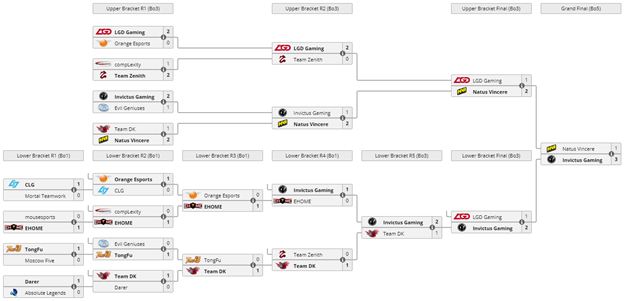
Although Na’Vi didn’t fare well in the group stages, they came to their own in the playoffs, and beat IG in 2-1 in the upper bracket semifinals. That series gave Dota 2 one of its most iconic moments, which is often referred to as ‘The Play’, immortalized for everyone by the casting of David “LD” Gorman.
But IG survived a bo1 in the lower bracket against the TI1 runners-up EHOME, and fought their way back to the grand final. The stage was set once again – East vs West, Ukraine vs China, just as it had been at TI1. A big difference this time though, was the fact that the team coming from the upper bracket did NOT have a 1-0 lead, like the previous year. So the grand final would start at 0-0, and not 1-0 in favor of Na’Vi, as was the case in Cologne.
Natus Vincere Roster
Alexander “XBOCT” Dashkevich
Daniel “Dendi” Ishutin
Dmitry “LighTofHeaveN” Kupriyanov
Clement “Puppey” Ivanov
Sergei “ARS-ART” Revin
Invictus Gaming Roster
Chen “Zhou” Yao
Luo “Ferrari_430” Feichi
Jiang "YYF" Cen
Wong "ChuaN" Hock Chuan
Zeng "Faith" Hongda
There were a few changes in the game, going from TI1 to TI2. The International 2011 was played on the 6.72d patch, while TI2 was played on the 6.74 patch. Besides hero changes, there were a few general changes that had a big impact on how the game was played.
Buyback was increased to 5 minutes in patch 6.73, seeing how EHOME had relied on buyback in the TI1 grand finals to hold on to their base and win the first game. The individual hero GPM was increased from 68.57 to 75, giving every team a slight 32.15 GPM boost. A big change was Io, Disruptor and Rubick being added to Captains Mode in patch 6.74. Two of those three went on to play major roles in the TI2 grand finals; but Io made up for it in the TI3 grand finals.
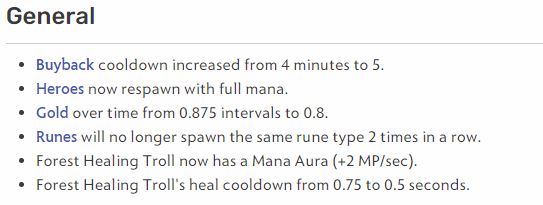
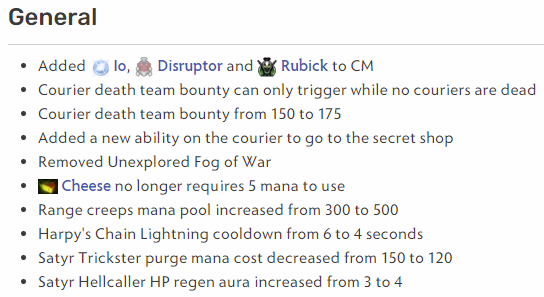
The number of ban and pick phases did not change over the course of the year, but the first ban phase did get an extra ban, taking the total number of bans in the game from four to five.

Game 1 (Na’Vi Radiant with first pick, IG Dire)
Na’Vi bans: Invoker, Morphling, Nature’s Prophet, Tidehunter, Lone Druid
IG bans: Lycan, Enigma, Anti-Mage, Juggernaut. Pudge
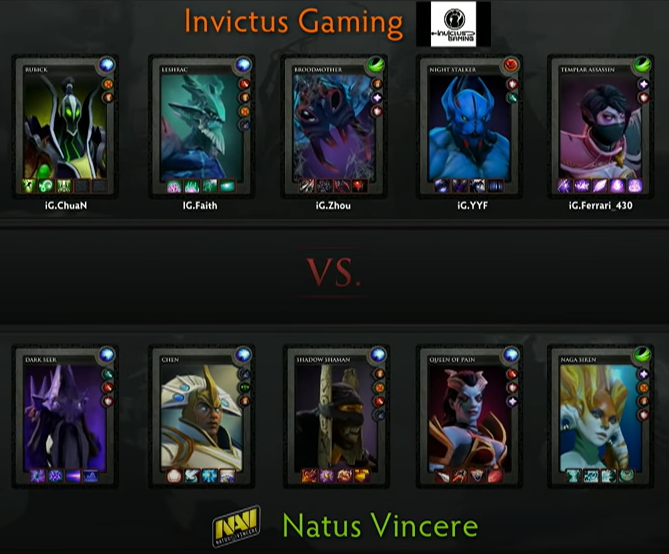
The gameplay at TI2 was a lot more structured than what was seen at TI1. Teams had had a year to buckle down and get their basics right, so the drafts were more thought out and there were no role swaps as such.
While TI1 was all about team fight, teams realized the importance of having heroes that could take objectives; heroes that made it easier to take down towers and buildings. That had been one of the issues in game 1 of the TI 1 grand finals, when Na’Vi tried and failed five times to take down EHOME’s mid barracks. Heroes like Shadow Shaman, Leshrac, Broodmother, Templar Assassin, Dragon Knight and one Druid gained importance for their high ground breaching capabilities.The importance of map control was realized by teams, with IG taking down all outer towers before trying to breach Na’Vi’s high ground, something that was not seen in the TI1 grand final.
Broodmother was played as a carry in the TI2 meta, which isn’t something seen too often these days. Once in a while, you might see teams put all their eggs in the Brood basket (ironic, as she is already carrying her own eggs around) and put their carry on a utility hero, but more often than not, she is a position 2 or position 3 hero.
Something just as weird was the fact the choice of boots for Templar Assassin back then was Phase Boots. Now fashion aside, TA is only seen to go for Power Treads, because the hero lacks attack speed. But a possible reason for that is the fact that players and teams hadn’t realized the optimum balance between farming and team fight, and with a lot more emphasis on fighting, Phase Boots provided the maximum amount of burst achieved from the Meld hit (more the damage, higher the benefits of armor reduction).
Na’Vi had more than a few misplays in game 1, and IG snowballed off of a Queen of Pain pickoff in the mid lane to take the middle barracks, and claimed the game without having to leave the Na’Vi base.
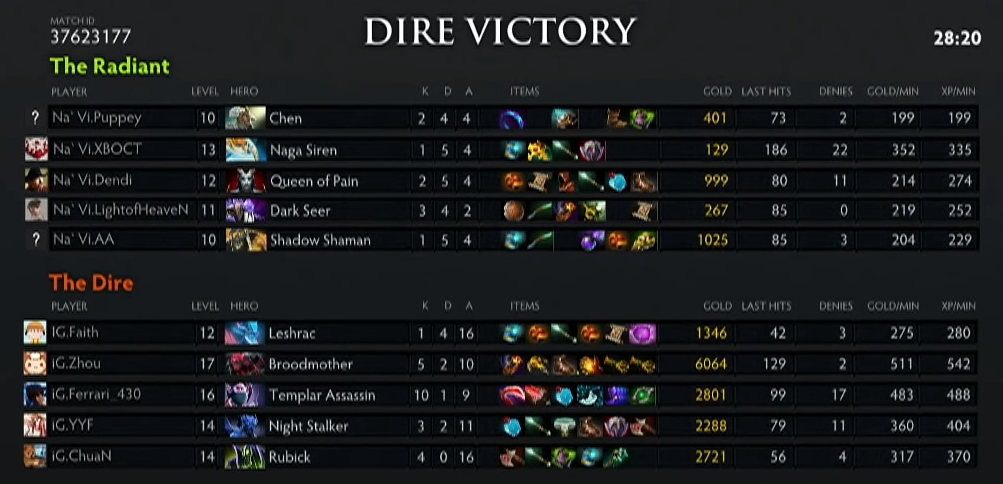
Game 2 (IG Radiant with first pick, Na’Vi Dire)
IG bans: Lycan, Enigma, Anti-Mage, Juggernaut, Pudge
Na’Vi bans: Invoker, Morphling, Nature’s Prophet, Shadow Shaman, Tidehunter
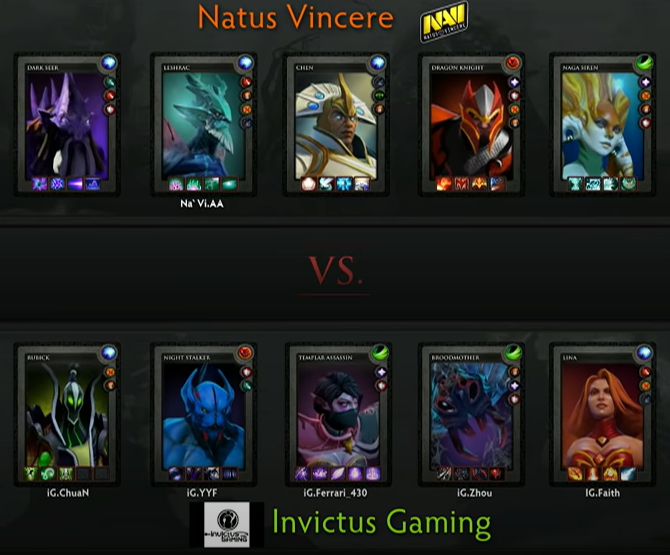
One thing that did carry on from TI1 to TI2 was the habit of building early Vanguards on cores. In game 1, Naga Siren and Night Stalker got one, and it was the same story in game 2.
A Naga Siren building Arcane Boots today would be preposterous, but that was the case back then, and it was something that continued for a long time, because Rip Tide was an active ability, making Naga Siren a hero with four active abilities. From Dota 2 patch 6.84 onwards, Naga players started using the Energy Booster from Arcane Boots for Octarine Core, but till then, the boots just carried on till the end.
In game 2, Na’Vi got their act together and with some perfect Song of the Siren into Vacuum-Wall of Replica combos, made short work of Invictus Gaming in 19 minutes.
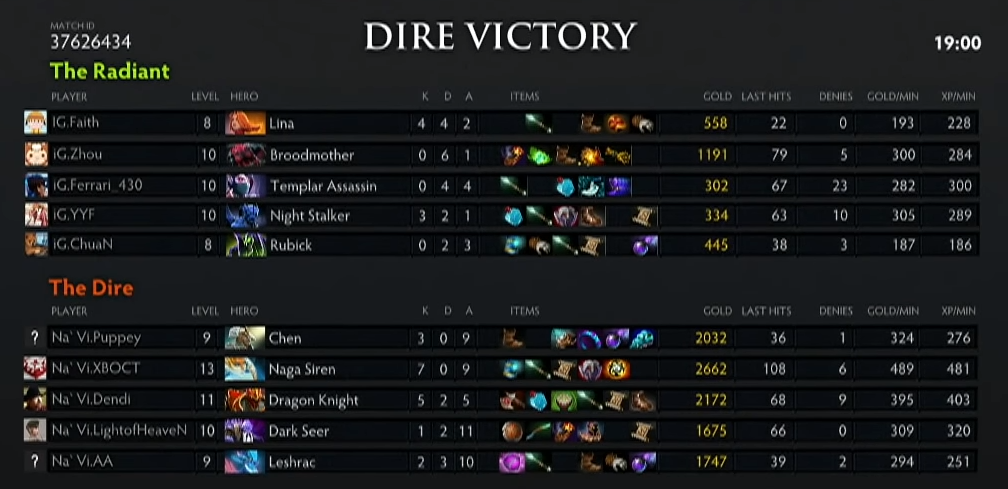
Game 3 (Na’Vi Radiant with first pick, IG Dire)
Na’Vi bans: Invoker, Morphling, Leshrac, Tinker, Venomancer
IG bans: Lycan, Anti-Mage, Chen, Tidehunter, Enchantress
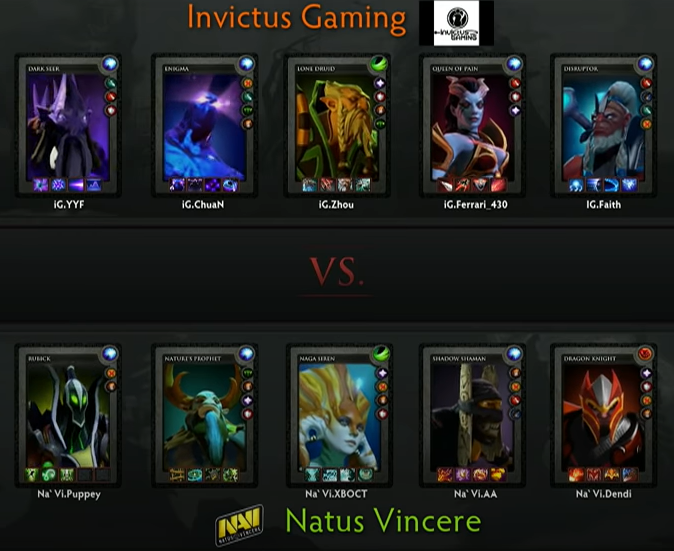
In game 3, IG decided to switch from Broodmother to Lone Druid for their carry. Na’Vi went for Naga Siren for a third straight game in a row. Now the contrast between these two carries is that Naga’s build was Arcane Boots, Vanguard into Radiance, which meant she didn’t typically get her Radiance till after 20 minutes. But for Lone Druid, Radiance was the first item in the build as the hero himself was tanky because of his ultimate, True Form.
Lone Druid’s Radiance came a lot early, and his farm rose exponentially. By the time IG came knocking on Na’Vi’s barracks, Lone Druid had a lot more farm than Naga Siren, and the Ukrainian outfit had no answer for both the cores of the Chinese team.
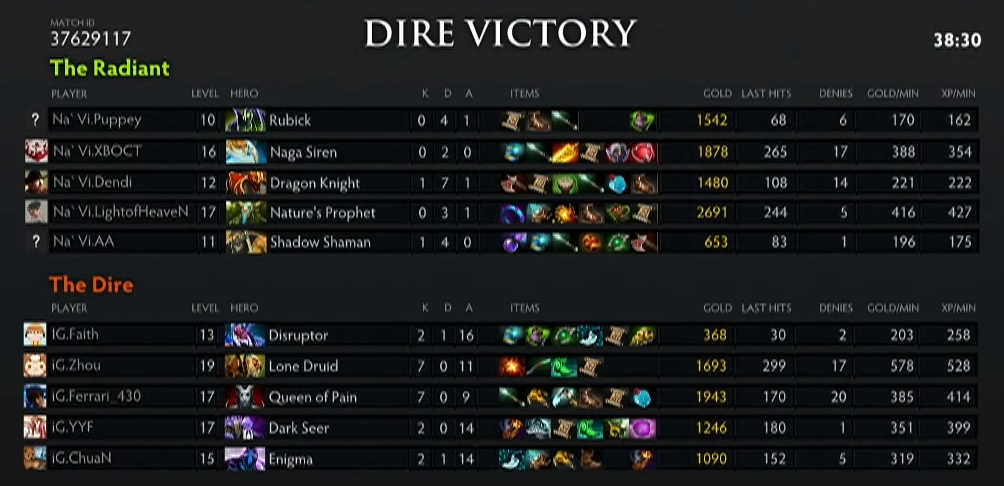
Game 4 (IG Radiant with first pick, Na’Vi Dire)
IG bans: Lycan, Enigma, Anti-Mage, Enchantress, Chen
Na’Vi bans: Invoker, Morphling, Nature’s Prophet, Disruptor, Shadow Shaman
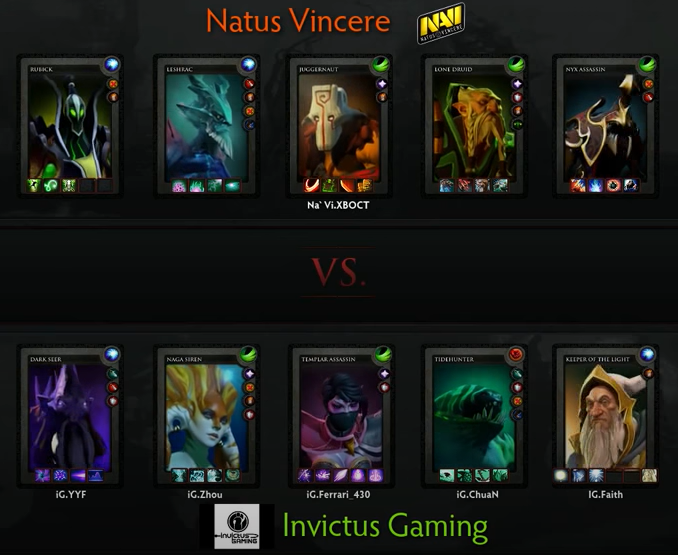
Rubick was a very popular pick at TI2. He was picked in all four games of the TI2 grand final, but Na’Vi had the chance to flex him as either a support or mid, because Dendi could play a pretty good mid Rubick. That’s exactly what Na’Vi did in game 4! That wasn’t the only switch Na’Vi pulled though. They also picked two carries – Juggernaut and Lone Druid and put LightOfHeaven the bear in the offlane.
The game lasted for nearly an hour, but IG were in control for the most part. There were only a few fights in between where Na’Vi showed a bit of resistance, but nothing that turned the tides. XBOCT was a position 1 Juggernaut, but with a first item Vanguard and no farming item like Battlefury or Maelstrom, he ended up with 248 GPM, something that would be very unlikely to find on the hero in today’s game. The only farmed hero on Na’Vi’s side was LightOfHeaven's Lone Druid, and he could only do so much. IG played it patiently and saw the game out eventually, taking the Aegis to China for the first time.
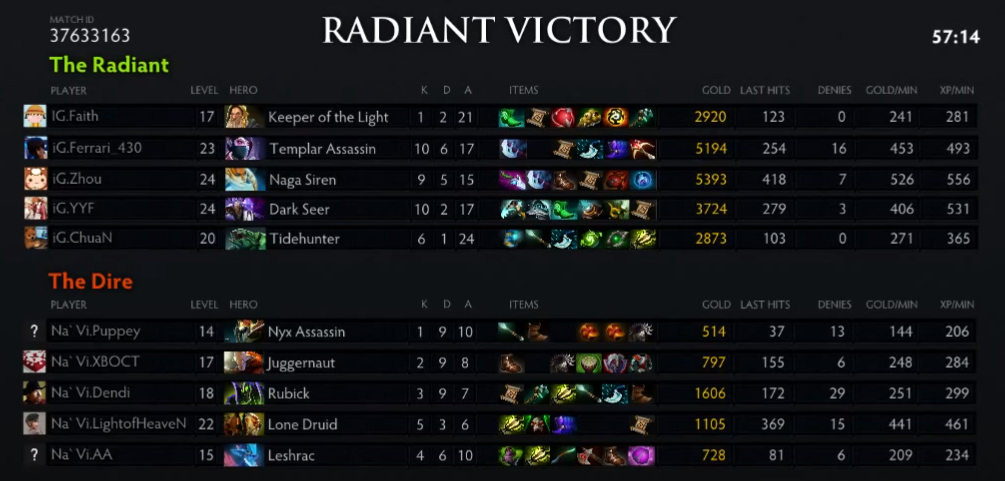
The most beautiful thing to see was Puppey coming out of his booth and hugging the Invictus Gaming players! That kind of camaraderie is hardly seen so explicitly in today’s game (it might be the case off screen, but not so much on stage).
GPMs
The team GPMs per game for the two teams throughout the series were:
Invictus Gaming: 1759
Na’Vi: 1421
So even with the increase in passive gold, the team GPMs were significantly lower than what we find today, which is around 2200-2600 in teams that make it to the final days of major tournaments.
With that, we come to the end of the deep dive into the grand finals of TI2 to see how the meta and playstyle compare to that of today. Even though there was quite a bit of structure and improvement from what we saw at TI1. Next week, we will get into the depths of the legendary five game final between Alliance and Na’Vi, and see how TI3 fared in comparison to the Tis before and after it.
